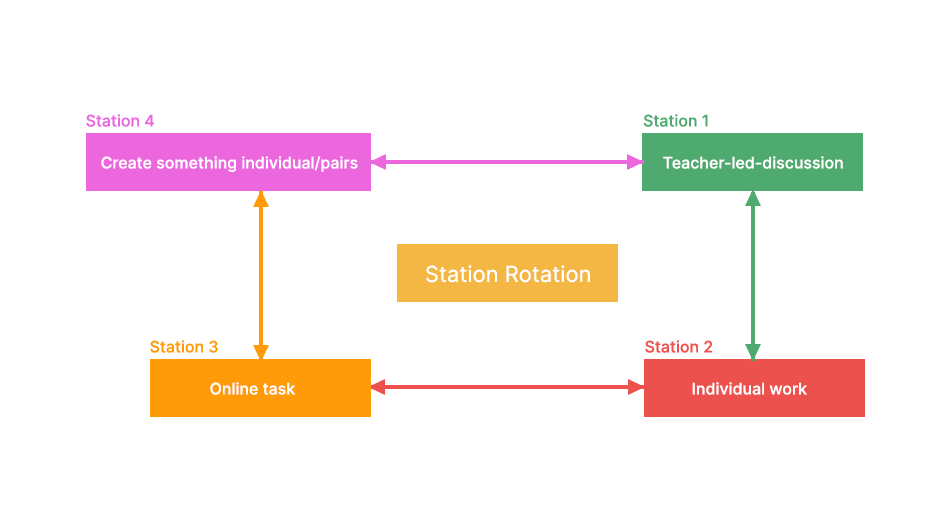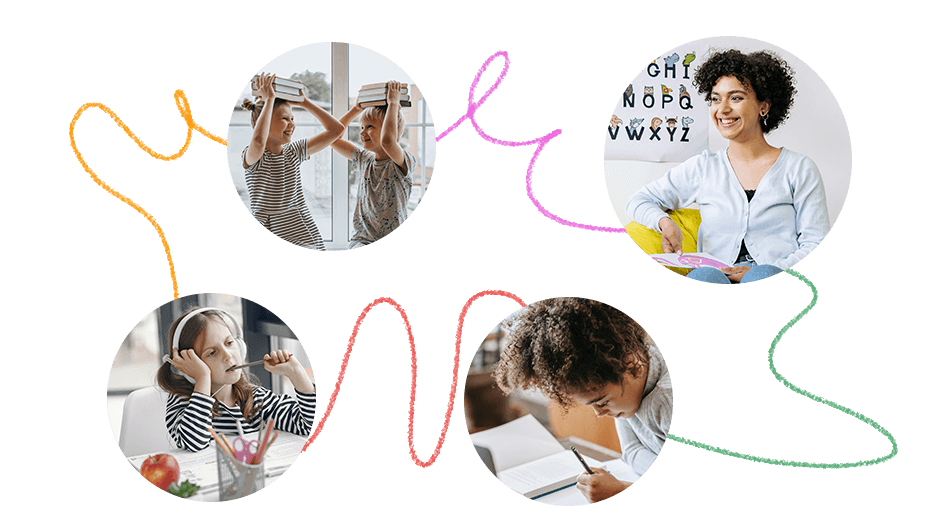How to make lessons engaging while meeting students’ diverse needs, is an eternal question for teachers. It’s a challenge just as relevant in the traditional classroom as it is in the virtual one. And so is one of its popular solutions. Most experienced teachers have applied, or at least heard of, the Rotation Station Model. But can this model be transferred to the virtual classroom and how?
What is the Rotation Station Model in Blended Learning?
The Blended Learning Rotation Station Model utilizes several teaching approaches during one lesson, all at the same time. This blended learning model is a combination of synchronous and self-paced methods, that makes the most of digital learning technology. It draws on the traditional rotation station model, where students are divided into groups and rotate across three or more stations.
Typical examples of such stations are 1. Lecture (face-to-face training), 2. Individual work (e-learning), and 3. Group work or projects. The sequence of the stations may vary, but there are several popular options. For example, students start by taking an e-learning module as pre-work. After that, they attend a live session, where they can discuss the topic with peers and the teacher, to deepen their understanding. Finally, students re-join their group for a mutual project. Alternatively, the first station can be a live lesson, followed by an e-learning and then a group project.

When is it best to use the Rotation Station Model
Large groups of diverse learners can benefit greatly from the Rotation Station Model. The teacher can pair or group students by age, skills, needs, or interests. Of course, this doesn’t mean that they should always put learners with the same level of skills in one group. The reason is that this could lead to isolation and have a negative impact on student progress. Therefore, teachers should be conscious of individual needs and abilities, while also being sensitive to group dynamics.
Dividing larger groups into different stations can make classes more manageable and enhance personalization. When students are clustered into smaller groups, it becomes easier for the teacher to notice those who are struggling and need additional attention. Or just the opposite – identify students that could benefit from extra challenges. Once teachers have a grasp on this, they can plan lessons strategically to target these students.
Another great benefit of rotation stations is the variety they provide. It’s a well-known fact that experiencing different means of learning enhances knowledge retention. Since students spend only a limited amount of time at each station, it’s easier for them to stay alert and actively participate in the lesson.

What to have in mind when applying the Rotation Station Model in the virtual classroom
To apply the Rotation Station Model, you need to plan your lesson carefully and take the time to prepare resources for each station.
As with any traditional classroom method you adapt for online delivery, there are some considerations to keep in mind. In this case, instead of having dedicated physical spaces, you will need to organize the stations into breakout rooms.
You should have a very clear idea about the setup of every station and how students will switch between them. Practice creating and managing breakout rooms if you haven’t used this tool previously. Make sure you have all instructions handy and a convenient time-tracking device or application, ready to use.
Be very specific about the time students will spend at each station, and what they will experience or produce in that slot. Make your instructions fool-proof, so learners can work independently at each station. Otherwise, you risk getting distracted with providing extra guidance, which can derail your whole lesson.
The last, but no less important step, is the preparation of your resources. Developing the learning materials for your Rotation Station-based class will take a significant amount of time, but it’s an investment. Once you have your initial set of resources ready, all you have to do is revise and update them occasionally. To further streamline your preparation process, use the session templates, available in VEDAMO’s virtual classroom.

How to plan and prepare a Rotation Station Blended Lesson in the virtual classroom
As with any lesson, start with the learning goals. What you are trying to achieve will determine the approach. If you’re teaching students how to use new software, focus more on the individual work station. This also means that you will have to spend more time and effort developing e-learning resources. For example, tutorials, step-by-step instructions, process walkthroughs, and similar. If you’re using an LMS platform, you can upload and arrange all resources in a shared file library. You can also create automated quizzes for students to test their knowledge. This way you see the results immediately and can provide feedback before they move on to the next station.
And if you’re teaching soft skills, it will make sense to devote more time to group practice. Be sure to provide learners with comprehensive instructions, so they can effectively perform the task on their own. This type of group activity can be preceded by an individual learning station. At this station, students can also see examples of the soft skills in action. It’s a good idea to show them video roleplays like the ones they will re-enact at the group work station.
The Rotation Station Model for Blended Learning is a great way to reach your students and create an engaging learning experience. It’s also an opportunity to make the most of the resources and capabilities available in your virtual classroom. Perhaps one of its drawbacks is that its time-consuming to plan and prepare. This is worth it, though, since the initial investment is guaranteed to pay off. A well-developed Rotation Station lesson is an efficient tool that will serve you well in your work as an online teacher.
